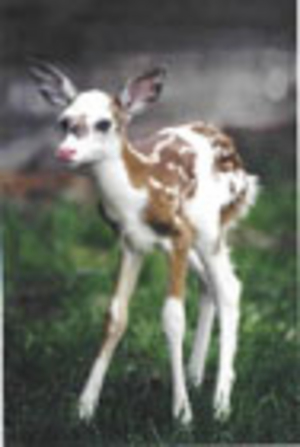Most of us are familiar with whitetail deer.
They’re those brown animals with the white under tail that have such a habit of running out in front of our cars when we’re doing 60 miles an hour. They’re also the ones that have such adorable spotted fawns. They’re the animal that thousands of men don camouflage and strap on a rifle to go out once a year and hunt. They’re the animal you are most likely going to find hanging on a hunting cabin wall ( usually, along with a large mouth bass).
What most of us are not aware of, though, is that there are actually 5 different hair colorations in the whitetail deer population.
Most common is the aforementioned brown whitetail. This is the “normal” whitetail deer. Depending on the season, these deer will have either reddish/brown fur (summer coat) or grayish/brown fur (winter coat). Fawns have white spotted brown coats which turn all brown within a few months.
This brown coloring allows the whitetail deer to blend in with the surrounding vegetation. If one is laying perfectly still in under brush, it is almost impossible to detect it as its coat blends with the color of the woods. Its rack, if it has one, will just look like limbs or branches. All this serves to give it some protection from hunters and other predators.
Another often heard of, but not often seen, coloration of whitetail is the albino. An albino has no body pigment at all, resulting in pink eyes, pink nose, pink hooves and white fur year round. Even the velvet which covers their growing antlers is pinkish.
Albinism is a recessive trait, so breeding an albino to a normal brown whitetail would not produce another albino unless the brown deer has the albino gene, too. Both deer must have the albino gene to produce albino off spring. Albinos are noted for not being as healthy and hearty as brown whitetail.
Due to there being no pigment in their eyes which lets in too much light, they have poor eyesight. Being all white, albinos are not protected by their color in the woods unless snow has caused everything else to be white, too.
It is illegal in some states to shoot an albino deer. Also, many people have a superstitious belief that it is bad luck to kill an albino deer. There is much folk lore surrounding albinos, attributing to them the power to provoke either very good or very bad luck.
Another coloration that is becoming more well known is the Piebald, sometimes called a Pinto. Piebalds are actually 2 or 3 colors, either white and brown or white, brown and gray.
Upon seeing one for the first time, many people will assume that the piebald was created by breeding a brown deer to an albino. This is not the case. Like albinoism, piebaldism is a recessive trait which is passed down through genetics. Piebalds are being seen more in the wild than they used to be, possibly because the gene is being passed on through inbreeding.
Because of their coloring and the placement of the areas of coloration, sometimes piebald fawns can, amazingly, look like brown and white calves. A piebald can be mostly brown with some white, almost all white with some brown, or any mixture in between.
The forth type of coloration is not very common and is often confused with the albino. It is the white whitetail. This deer will have white fur all year round, but will not have the pink eyes, nose and hoofs of a true albino. Unless you are close enough to see the brown nose and blue or brown eyes, a white whitetail will usually be mistaken for an albino. Unlike the albino, though, the white whitetail is just as hearty as the brown whitetail. But, like the albino, the white whitetail has no protective coloration in the wild unless snow is present.
And last coloration oddity is the melanistic whitetail. This is a whitetail with too much pigmentation causing it to be very, very dark brown or even black. This is the rarest pigmentation type of all and reports of its actual existence are few and far between although pictures have been taken of melanistic whitetail that have been shot during hunting season. Most reports of melanistic whitetails come from Texas and with time, it is possible that inbreeding in the wild will begin to produce more of them which will, in turn, produce a greater volume of knowledge about them.




